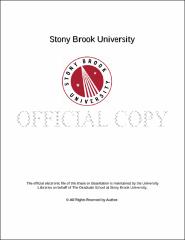| dc.identifier.uri | http://hdl.handle.net/11401/77030 | |
| dc.description.sponsorship | This work is sponsored by the Stony Brook University Graduate School in compliance with the requirements for completion of degree. | en_US |
| dc.format | Monograph | |
| dc.format.medium | Electronic Resource | en_US |
| dc.language.iso | en_US | |
| dc.publisher | The Graduate School, Stony Brook University: Stony Brook, NY. | |
| dc.type | Dissertation | |
| dcterms.abstract | All-carbon conjugated materials, the high electron-rich system, have attracted great interest for their outstanding electronic and optical properties. As a potential alternative, polydiacetylenes are also highly unsaturated and conjugated, considering as “tunable†carbon rich materials. In this work, diiodobutadiyne can be aligned in an ordered way in solid state with help of bis(pyridyl)oxalamides which are self-organized by hydrogen bond. Although diiodobutadiyne cannot polymerize at ambient condition, possibly due to spatial strain between host and guest. We were able to polymerize it under high pressure via diamond anvil cell using in-situ Raman to monitor the polymerization process. Confirmed by X-ray diffraction analysis, a single crystal to single crystal transformation was obtained successfully. Dibromobutadiyne is an extremely unstable compound which could decompose, even explode at room temperature. By host-guest strategy, dibromobutadiyne formed cocrystal with bis(cyano)oxalamides at low temperature (-18°C). X-ray structure of one cocrystal was obtained in which the monomer was partially polymerized. In another cocrystal, monomer fully polymerized to afford polydibromodiacetylene (PBDA). Washing the cocrystal with solvents such as dichloromethane, THF and methanol, polymer was isolated successfully. Raman and 13C SS-NMR spectrum confirmed the major presence of PBDA. Later, we tried a series of post-polymerization reactions in order to modify PBDA. Using trans-dibromoalkenes as model compounds, we tried Sonogashira and Suzuki cross coupling reactions. By alternating model compounds and reaction conditions, we got few positive results and applied the same conditions on PBDA in cocrystal and isolated PBDA as well. Although these attempts are unsuccessful, they provide a novel method of controllable synthetic pathway for derivatives of polydiacetylenes. | |
| dcterms.available | 2017-09-20T16:51:43Z | |
| dcterms.contributor | Goroff, Nancy S | en_US |
| dcterms.contributor | Lauher, Joesph W | en_US |
| dcterms.contributor | Sears, Trevor J | en_US |
| dcterms.contributor | Rafailovich, Miriam H. | en_US |
| dcterms.creator | Jin, Hongjian | |
| dcterms.dateAccepted | 2017-09-20T16:51:43Z | |
| dcterms.dateSubmitted | 2017-09-20T16:51:43Z | |
| dcterms.description | Department of Chemistry | en_US |
| dcterms.extent | 136 pg. | en_US |
| dcterms.format | Application/PDF | en_US |
| dcterms.format | Monograph | |
| dcterms.identifier | http://hdl.handle.net/11401/77030 | |
| dcterms.issued | 2016-12-01 | |
| dcterms.language | en_US | |
| dcterms.provenance | Made available in DSpace on 2017-09-20T16:51:43Z (GMT). No. of bitstreams: 1
Jin_grad.sunysb_0771E_13043.pdf: 3631660 bytes, checksum: 0d355a85e3d55f0f6ca1df5fb58253c8 (MD5)
Previous issue date: 1 | en |
| dcterms.publisher | The Graduate School, Stony Brook University: Stony Brook, NY. | |
| dcterms.subject | Chemistry | |
| dcterms.subject | dibromobutadiyne, polymerization, single crystal transformation, topochemical | |
| dcterms.title | Topochemical Polymerization of Dibromobutadiyne and Diiodobutadiyne and Post-polymerization Attempts | |
| dcterms.type | Dissertation | |

